|
NATIONAL PARK SERVICE
Park Structures and Facilities |

|
BATHHOUSES and SWIMMING POOLS
PRIOR TO EMBARKING on a discussion of bathhouses for the use of swimmers, it is well to cite and dispose of another type of bathhouse necessary in parks that offer camp sites and cabins as recreational facilities. The bathhouse serving campground and cabin colony is dedicated to bathing as such and not as a misapplied synonym for swimming. In essence it is the bathroom of the camping community. It may be a single building divided for the use of both sexes, or may consist of two buildings. It is an essential feature where facilities for bathing are not supplied with each individual cabin or other unit of housing. With such a bathhouse it is usual to incorporate laundry trays and related equipment for the campers use. A drying yard in close proximity, screened by location or planting, is then a necessity.
Much of the ensuing discussion of bathhouses for swimmers is obviously and equally applicable to bathhouses for campers.
The era of the casual bathhouse in facilitation of swimming within publicly owned parks is passing. This more or less unsupervised building of the past, now giving place to the controlled bathhouse, is within the memory of all of us. As we dwell fondly on the summer holidays of youth, we perhaps find it difficult to recall clearly that dingy, ill-arranged, ill-maintained, and unhygienic structure. It was one of those pioneer structures in recreation that, after worthy apprenticeship cherished in memory, has since moved on to a more orderly and complete fulfilment of function. To cling to a nostalgic recall of the bathhouse of horse and carryall days is as illogical in present day park recreation as to insist upon that means of transportation, or bathing apparel of the same period.
Progress has overtaken the primitive bathhouse, just as it has forced more positive and more complex systems of sanitation within parks grown beyond the safe limits of that lack of sanitation tolerable only in the little-patronized area. Beyond doubt the ever-increasing use of public park facilities by people of widely different social strata is responsible for this trend, and its effects are beneficial and many. Supervisory control of the bathhouse or bathing pavilion has brought with it higher standards generally in all details of the structure and its accessories.
It has been subjected to tests for efficiency and hygiene and emerges very much in step with this year of grace. Whether operated directly or as a concession, a bathhouse in a public area should be so efficiently arranged and constructed that the greatest number of people are suitably accommodated at the lowest possible capital cost. This means, or should mean, the lowest possible charge for use. Here is no place for unnecessary spaciousness, or luxury, or operating system that does not fulfill this requirement. Here is no place for private dressing booths only, claimable under one rental for periods of many hours, and leading to vastness of structure if the demand use is to be met. Large and spacious buildings can only lead to an exorbitant use-fee if the investment is to be served, or to an inadequate financial return if the public is to be served as it has the right to expect—at a modest charge. A system that provides for a checking of possessions, while a patron is not actually occupying the dressing booth, multiplies the capacity and at the same time curbs the size of the building, and should lead to subsequent scaling down, theoretical at least, of the fee. The adoption of such a system is therefore an obligatory demand upon any park authority charged with determining the operating method of a bathhouse on public property, and not unaware of his responsibility.
Following demand for efficient conservation of space, the old practice of issuing keys for private dressing booths is replaced with open dressing space, or with booths that are only claimable during actual occupancy. Various arrangements for the safe-keeping of the bather's possessions while he is on the beach have developed. With the locker system, the bather is issued a key to a small compartment in which his effects may be locked up. With the basket system, he is furnished a basket or tray in which his possessions may be placed and checked with the attendant. The Westchester County Park Commission has given up the use of bathhouse lockers in favor of basket checking, for the reason that baskets can be sterilized more thoroughly and readily than lockers. This Commission prefers aluminum trays to wire baskets, because buttons and clothing are apt to catch and tear in wire mesh. The number of lockers or baskets provided should be nicely scaled to the capacity of the available dressing space, with due regard for whether the bathing is done in an artificial pool, where the time in the water is limited, or in a large body of water, where the time element is not a factor. For a given number of people, fewer lockers need be provided in connection with a pool than with a larger swimming beach where many of the bathers hold lockers or baskets for several hours.
Dressing space may be arranged in any one of several ways, or in combinations of these. For men and boys, one general open dressing room with benches and clothes racks is usual. Dressing booths, each equipped with seat and clothes hooks, either open front, curtained, or with doors, are sometimes provided. There is however hardly sufficient reason for providing these exclusively. It seems more reasonable to provide a limited number of dressing booths for the older generation, and a general dressing space for those younger patrons bred in the gymnasium-equipped public schools.
A general dressing space is less acceptable to women. Booths with curtains or doors are probably preferred by them, and if not provided to the exclusion of all open dressing space, should constitute the greater proportion of the space available. The younger woman of today, with her increasing participation in sports, probably does not demand the private booth as generally as her elders.
Showers are not only a desirable facility in all bathhouses, but are absolutely essential, and desirable in greater numbers, whenever the swimming is done in an artificial pool, and bathing with soap before entering the pool is obligatory. Showers for men may be in one general open area. For women they should be individual. It is illogical in bathhouse planning to make provision for women to dress in privacy in booths, and at the same time make necessary their traversing a public aisle to and from the showers. It would seem reasonable, if modesty is to be served, that it be served consistently. In a proper proportion, some few showers might well be provided in direct communication with groups of two or three booths, if available funds permit. Particularly is this true if the swimming is to be done in an artificial pool, with its compulsory preliminary bath.
Toilets should be conveniently and conspicuously placed where they must be passed on the way to beach or pool.
If the swimming is in an artificial pool, a foot-bath containing disinfectant to minimize the spread of foot infections should be provided in the passage from the dressing room to the pool so that its use cannot be avoided.
An understanding of hygiene has brought other changes to the construction and operation of the bathhouse. Almost always when swimming is in an artificial pool, bathers are required for sanitary reasons to use suits, caps and towels provided by the management. In connection with some swimming pools in metropolitan park areas, a physical examination is compulsory before entrance to the pool is permitted. This is a common-sense precautionary measure for any heavily used facility.
The value of sunlight and ventilation is lately more fully understood. One bathhouse dressing room arrangement that reflects in maximum this enlightenment is roofed only over the booths and toilets, leaving the aisles and any general dressing space open to the sky. What is more logical than this casting off of the frayed tradition that dressing space must be entirely sheltered? When the weather is too cold for dressing in semi-shelter it is likewise too cold for outdoor swimming.
Almost without exception a charge is made for the use of the bathhouse. The income is applied to operation and maintenance. The attendants' station or room, where fees are collected, where suits, towels, baskets or keys are issued to patrons, and possessions are checked, should be adroitly and compactly laid out in relation to entrance and lobby passages to men's and women's dressing rooms, so that supervision is complete and uncomplicated.
All the foregoing is by way of outlining the essentials of the basic modern bathhouse in a park. There are supplementary appurtenances that are often desirable but not exactly requisite, such as lavatories, drinking fountains, bathing suit wringers, hair driers, public telephones. There are dependencies, the incorporation of which will be determined by the operating policy or the funds available, such as office, rest rooms, first aid room, and life guards' retiring and locker room. If suits and towels are rented, unless the laundering is done off the premises, a laundry and drying room are necessary. There are unrelated features that policy, expediency, economic and other considerations may make it reasonable to incorporate, and which forthwith transform the bathhouse into a pavilion, community or combination structure. Police or employees' retiring and locker rooms, employees' living quarters, winter storage space, concessions for the sale of food, drink, candy, tobacco, and toys, and for the rental of beach gear, with all the necessary dependencies of these, may make the bathhouse a large and complex structure.
Those persons not bathing but wishing admission to the shore are often required to pay a nominal fee for this privilege if the beach area is limited and can be enclosed. This regulates crowding, and a turnstile entrance with change booth nearby is the usual and business-like means of control. Park regulations against taking food onto the beach and against persons in bathing suits leaving the immediate beach area, may be most easily enforced at the turnstile. Many parks see fit to prohibit the changing of clothes in automobiles or places other than the bathhouse provided for this purpose.
To back-track from these features sometimes auxiliary to bathhouses to a concluding consideration of the bathhouse proper, it cannot be too forcefully urged that in the choosing of materials and equipment entering into such a structure, the readiness with which these can be maintained in whole and clean condition should be carefully weighed. Just as for park toilets, the standard of maintenance is geared to the durability and cleanability of the materials used. Maintenance funds are too often insufficient, but a wise choice of materials can offset this lack within a reasonable limit. Failure to maintain suitably bathhouse and toilet facilities is a fair and proper target for complaint by a public that will be apathetic to equivalent lack of maintenance in the case of almost every other park facility.
Although the heading couples bathhouses and swimming pools it is not intended to limit the consideration of bathhouses to those in conjunction with swimming pools only. Nor is it attempted to treat in detail the swimming pool as a park structure. The swimming pool is strictly an engineering problem, so complex as to warrant thorough and detailed treatment if gone into at all. Our present interest in the swimming pool is entirely concerned with its place in the public park and its relationship to the bathhouse that serves it. It is so touched on in the plates and illustrations that follow. It is assumed that desired information bearing on the construction principles and details of swimming pools, being elsewhere available, will be elsewhere sought.
If the swimming is done in a large body of water, a float for bathers is often a practical requirement. This facility is a level platform carried on pontoons and anchored where the water is of suitable depth. It is regularly equipped with diving board and sometimes with seats for the bathers. It is an especially practical feature where the water level is not constant, and where there is real advantage in the offered possibility of mooring at different locations.
The diagrams and illustrations of specific successful examples which follow, seek to convey typical groupings and relationships of the several component parts of the bathhouse and swimming pool as public park structures.
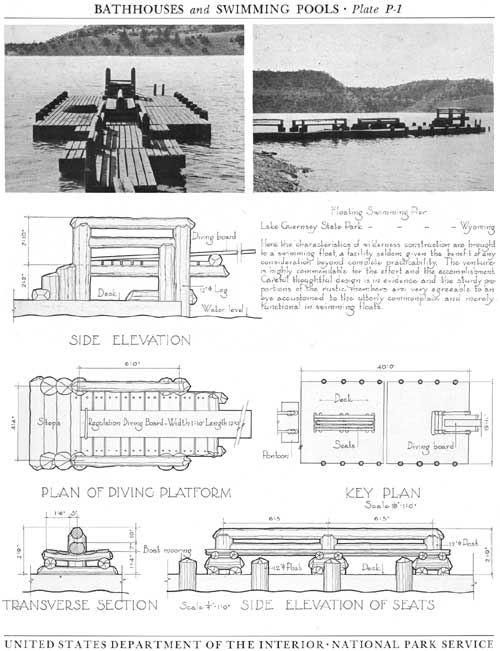
|
| Plate P-1 (click on image for a PDF version) |
Bathhouse, Westmoreland State Park, Virginia
Modest in size and in materials employed, this bathhouse has many excellent features. The plan permits one man control of both bathhouse and adjoined concession. The sight lines are well baffled. The provisions of individual booths in the women's section and open dressing space in the men's section are very reasonable. If it were sought to adapt the building to use with a swimming pool, the plan offers possibility of turnstile control and foot-bath with only minor revisions.
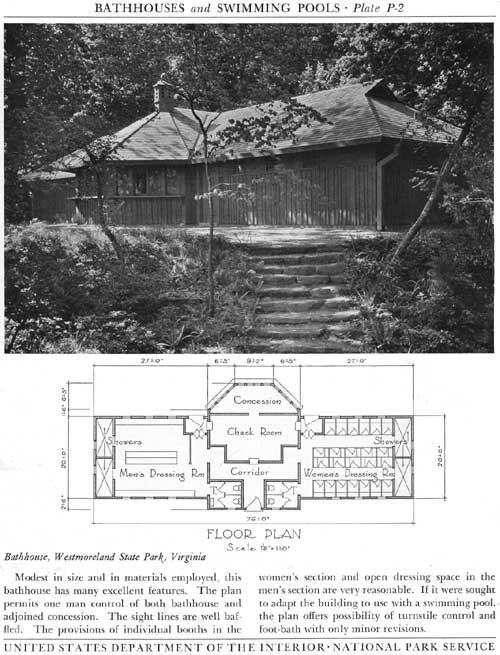
|
| Plate P-2 (click on image for a PDF version) |
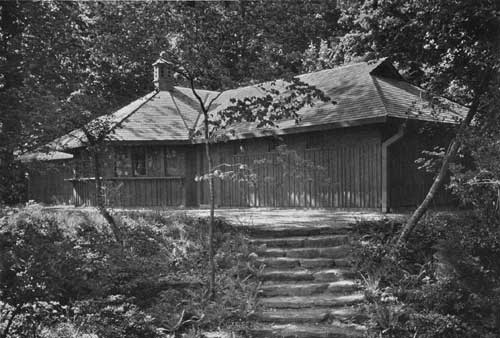
|
| Westmoreland State Park, Virginia |
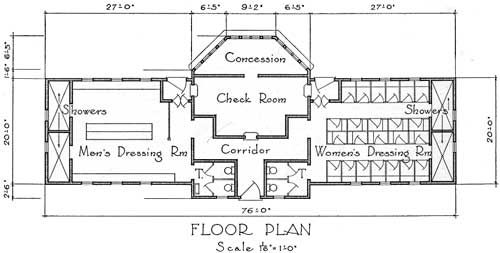
|
| Westmoreland State Park, Virginia |
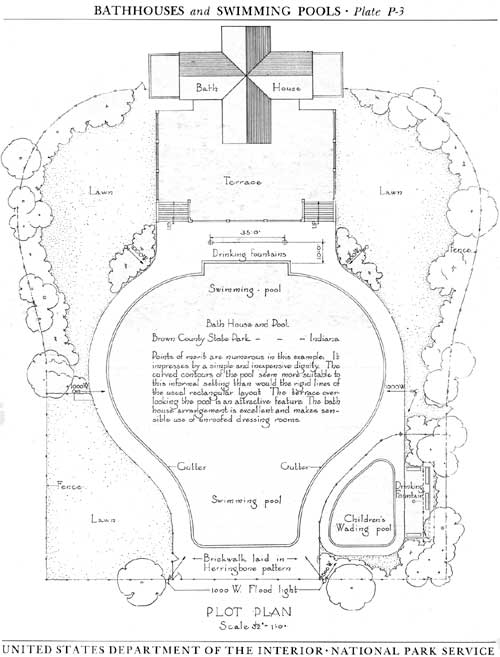
|
| Plate P-3 (click on image for a PDF version) |
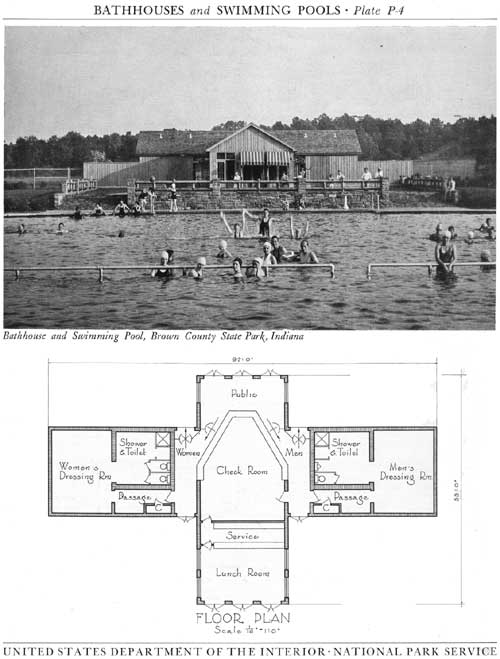
|
| Plate P-4 (click on image for a PDF version) |
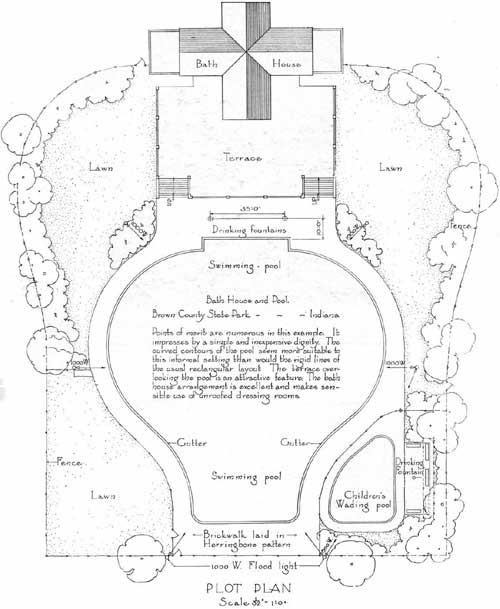
|
| Bathhouse and Swimming Pool, Brown County State Park, Indiana |
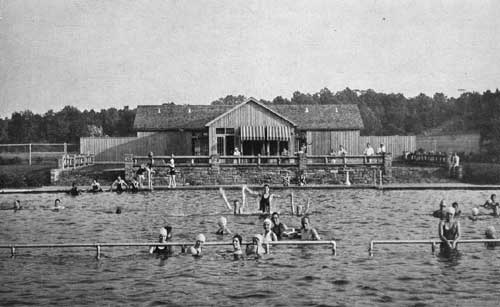
|
| Bathhouse and Swimming Pool, Brown County State Park, Indiana |
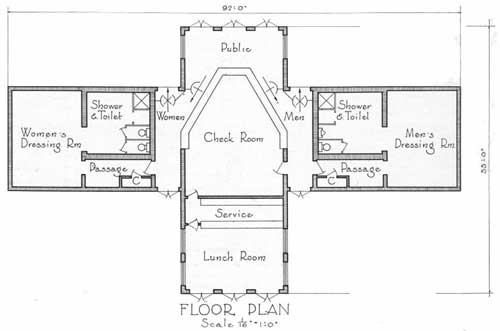
|
| Brown County State Park, Indiana |
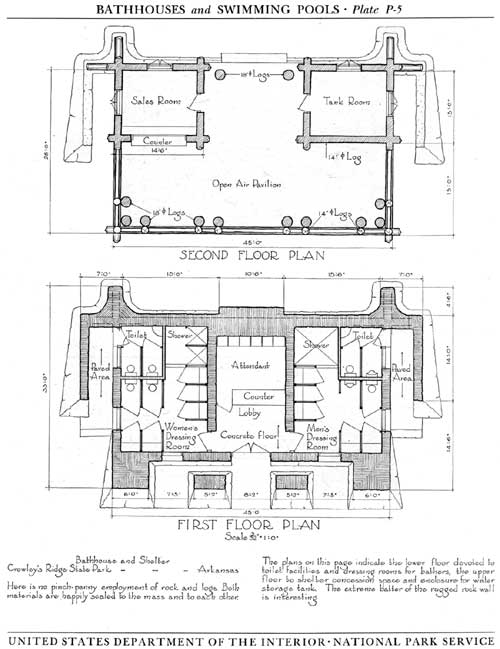
|
| Plate P-5 (click on image for a PDF version) |
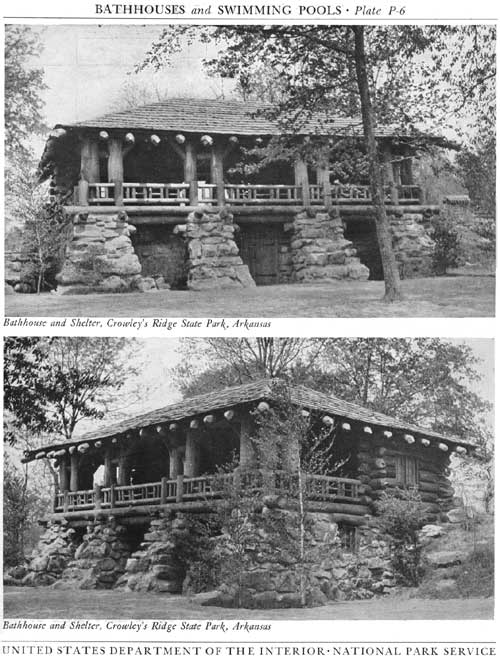
|
| Plate P-6 (click on image for a PDF version) |
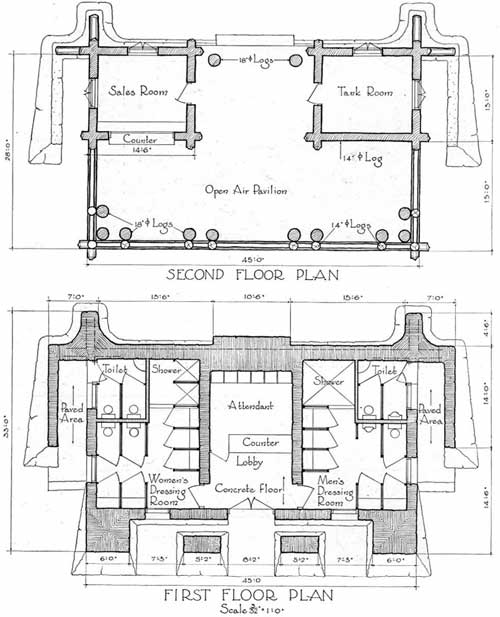
|
| Bathhouse and Shelter, Crowley's Ridge State Park, Arkansas |

|
| Bathhouse and Shelter, Crowley's Ridge State Park, Arkansas |

|
| Bathhouse and Shelter, Crowley's Ridge State Park, Arkansas |
Bath-house and Shelter, Petit Jean State Park, Arkansas
Apology for the presence in a natural park of a structure so appealing as this need not be profuse. It is possible that this building, as here presented, is a triumph that the designer must share with the photographer. If aesthetic shortcomings are present the quality of the photographs blinds us to them. Here are found complete harmony with surroundings and a primitive informality that is an enviable accomplishment. The steep slope makes both shelter with concession space above, and bathhouse facilities beneath, directly accessible from grade levels. On the facing page are shown the plans.
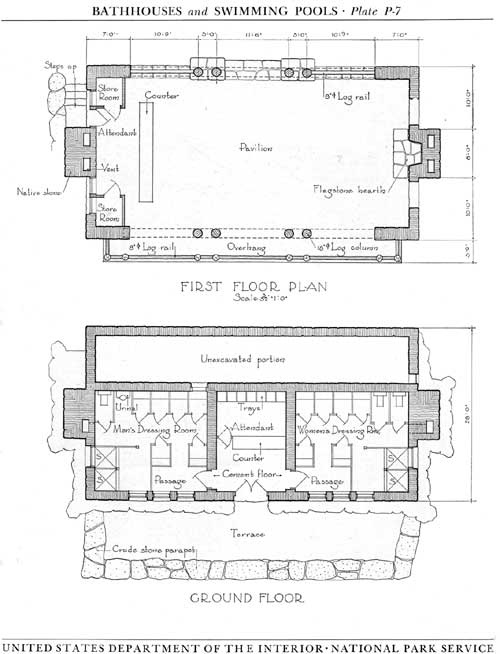
|
| Plate P-7 (click on image for a PDF version) |
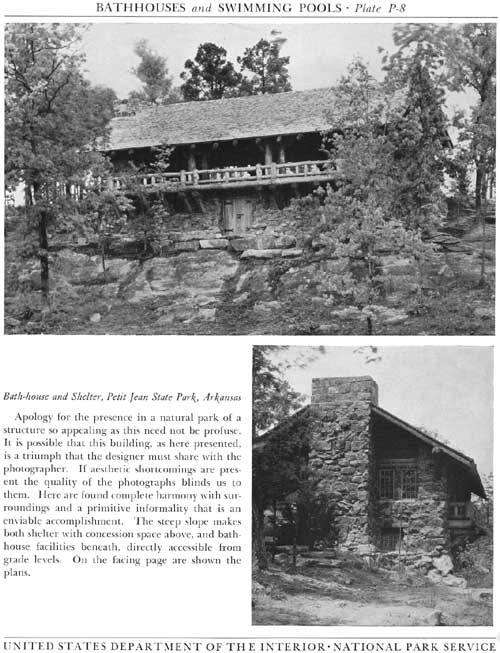
|
| Plate P-8 (click on image for a PDF version) |
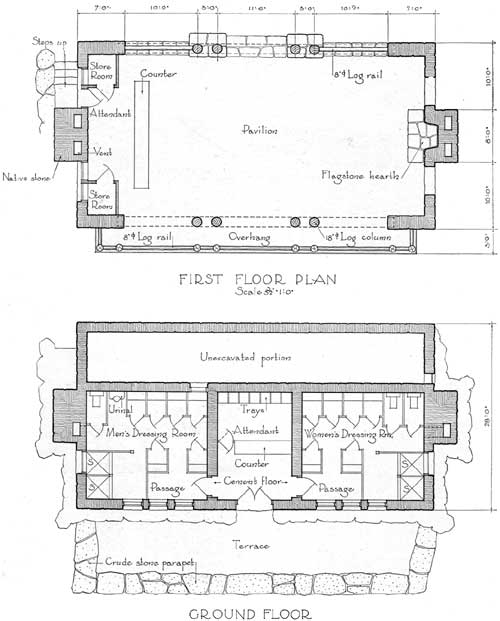
|
| Bath-house and Shelter, Petit Jean State Park, Arkansas |
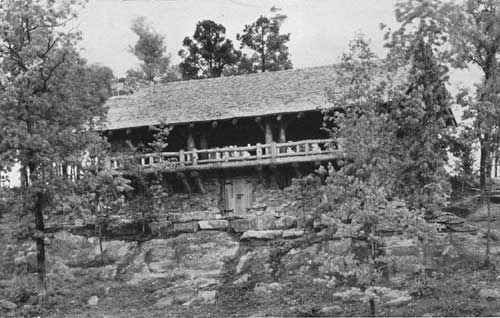
|
| Petit Jean State Park, Arkansas |

|
| Petit Jean State Park, Arkansas |
Bath House, McCormick's Creek, Indiana
This bath house serving an artificial pool is highly practical in arrangement. One attendant centrally located can wait on both men and women customers, who, upon payment of the fee, enter the fenced-in pool area by one-way turnstiles, then reenter the dressing rooms. Booths serve the women, open dressing space the men. The absence of disinfecting foot bath between dressing rooms and pool will properly be questioned. The architectural feeling of the building is agreeable, although rather more finished than is usual in natural park areas.
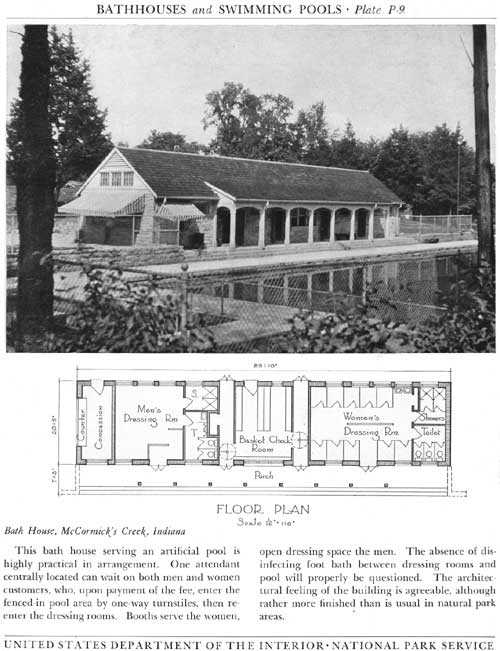
|
| Plate P-9 (click on image for a PDF version) |
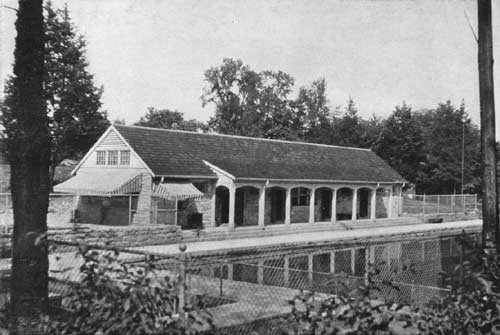
|
| McCormick's Creek, Indiana |
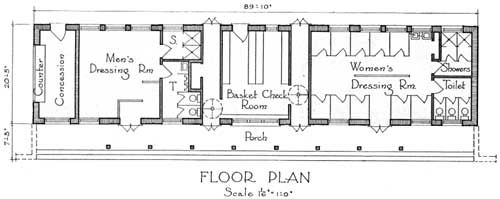
|
| McCormick's Creek, Indiana |
| <<< Previous | <<< Contents>>> | Next >>> |
park_structures_facilities/secp.htm
Last Updated: 5-Dec-2011